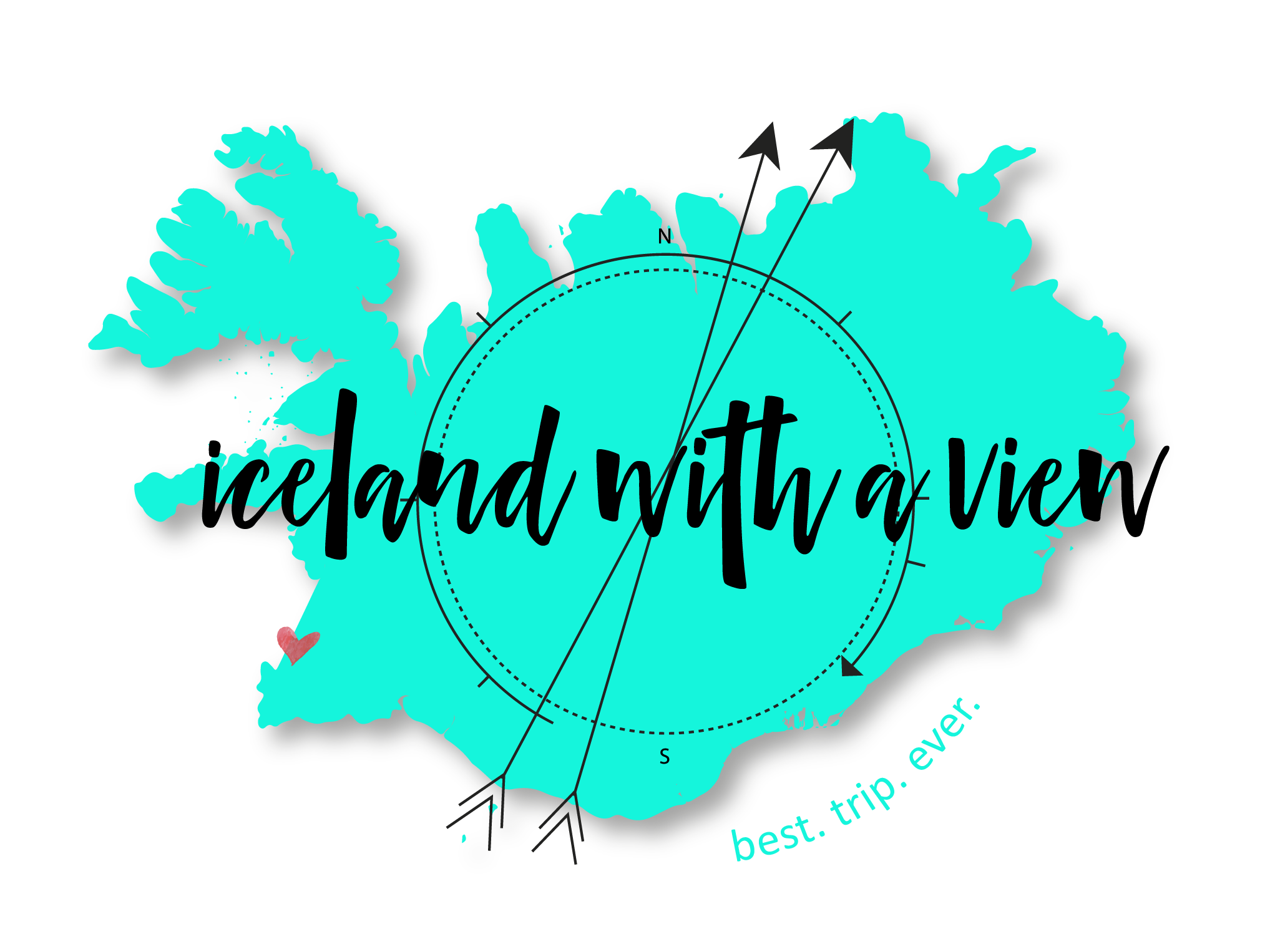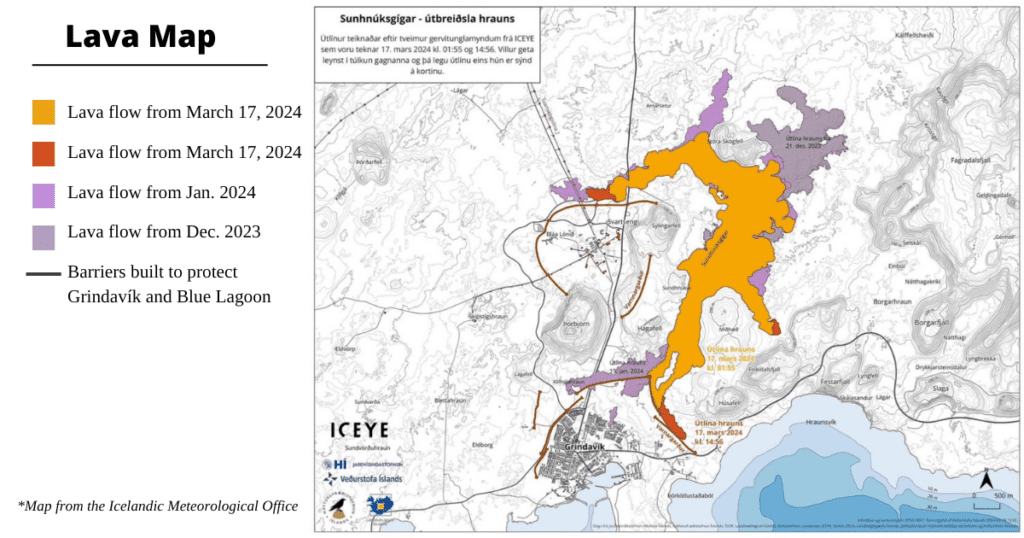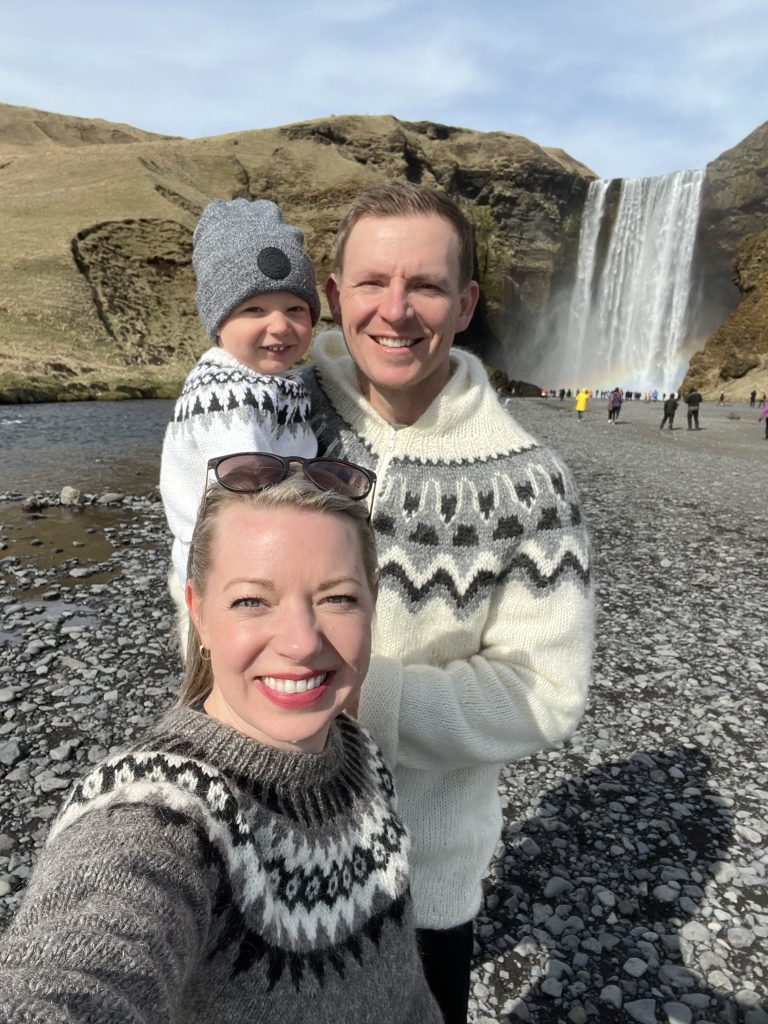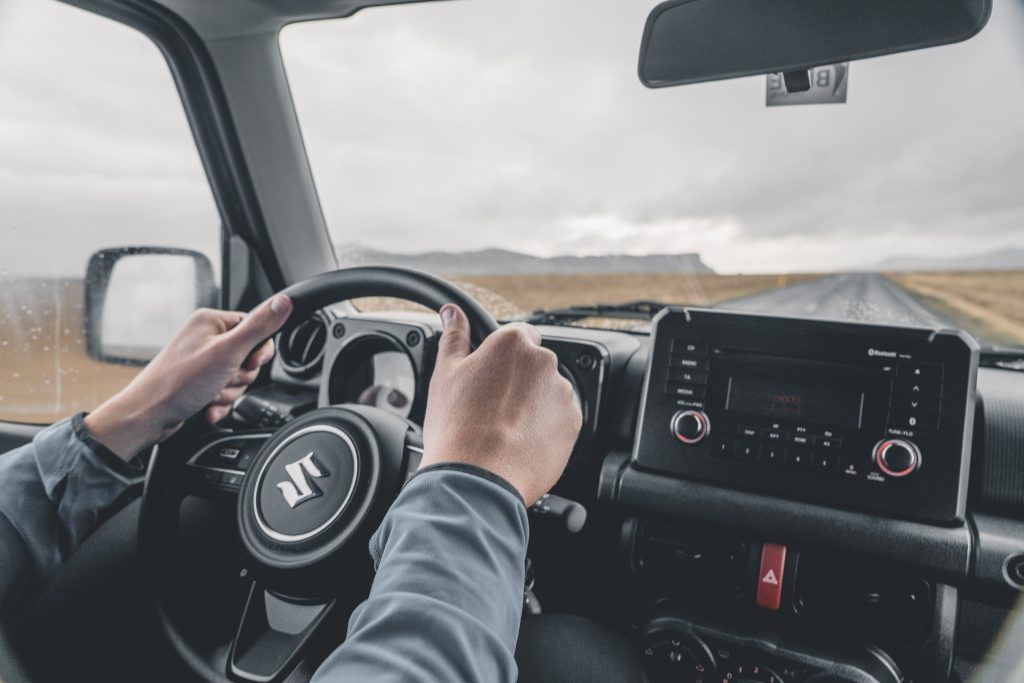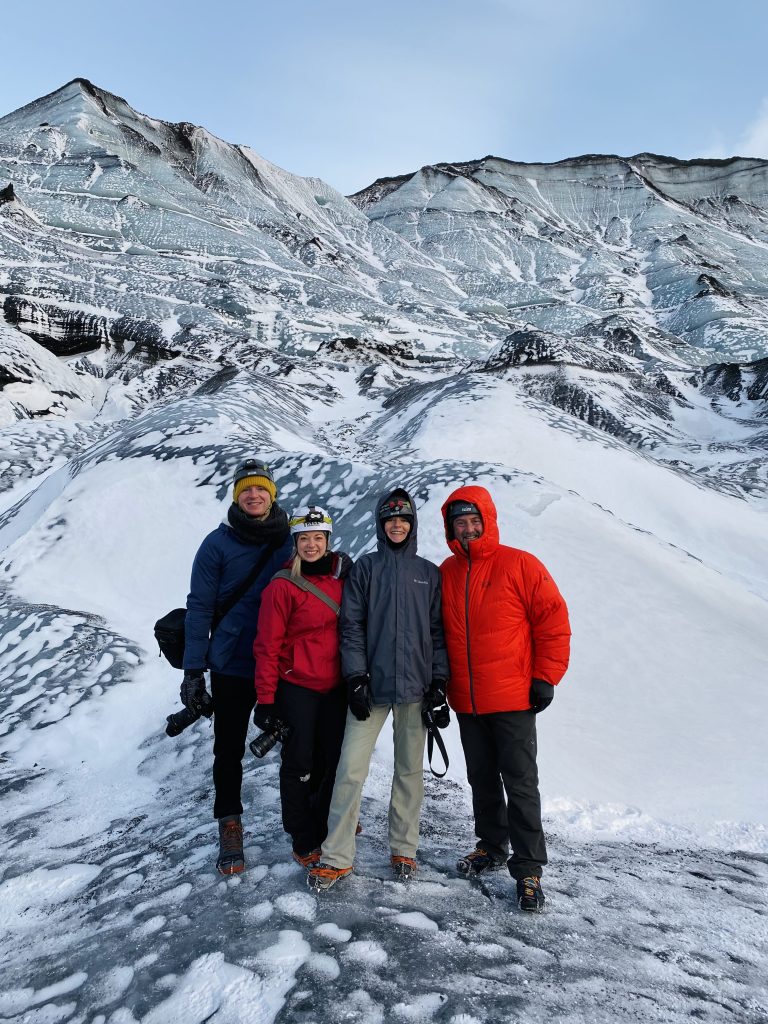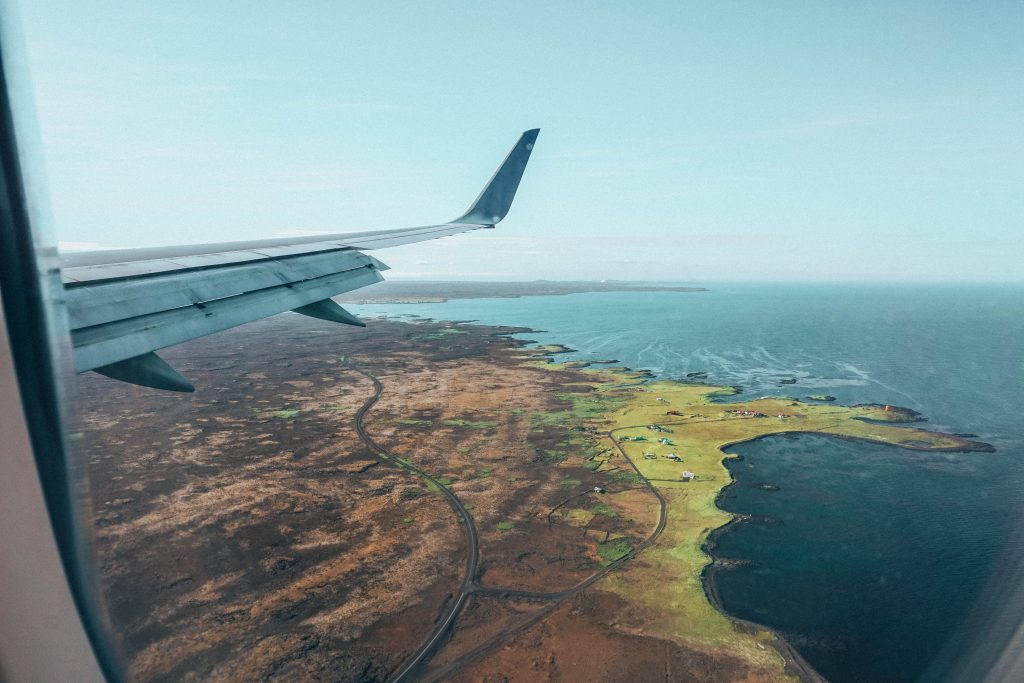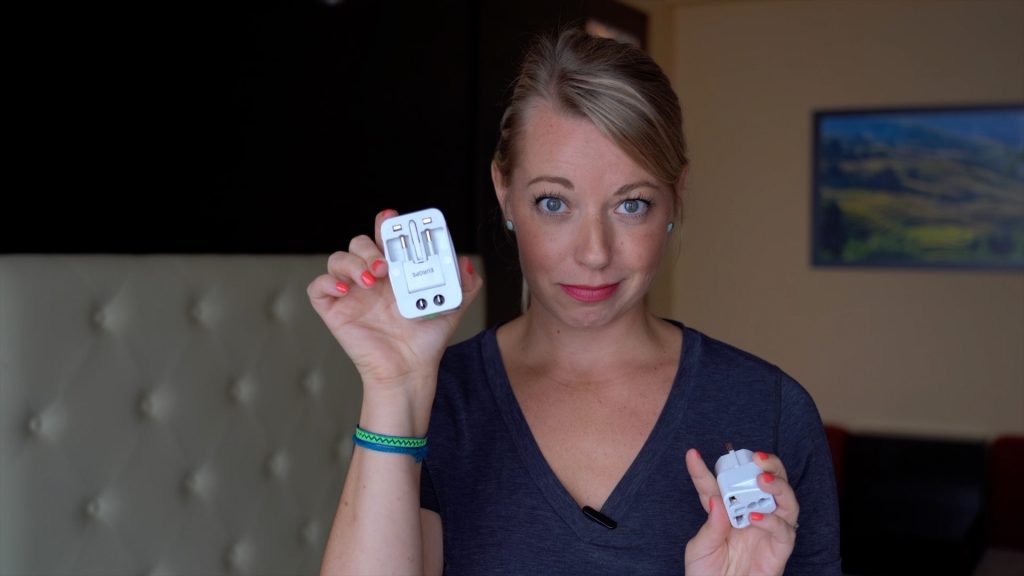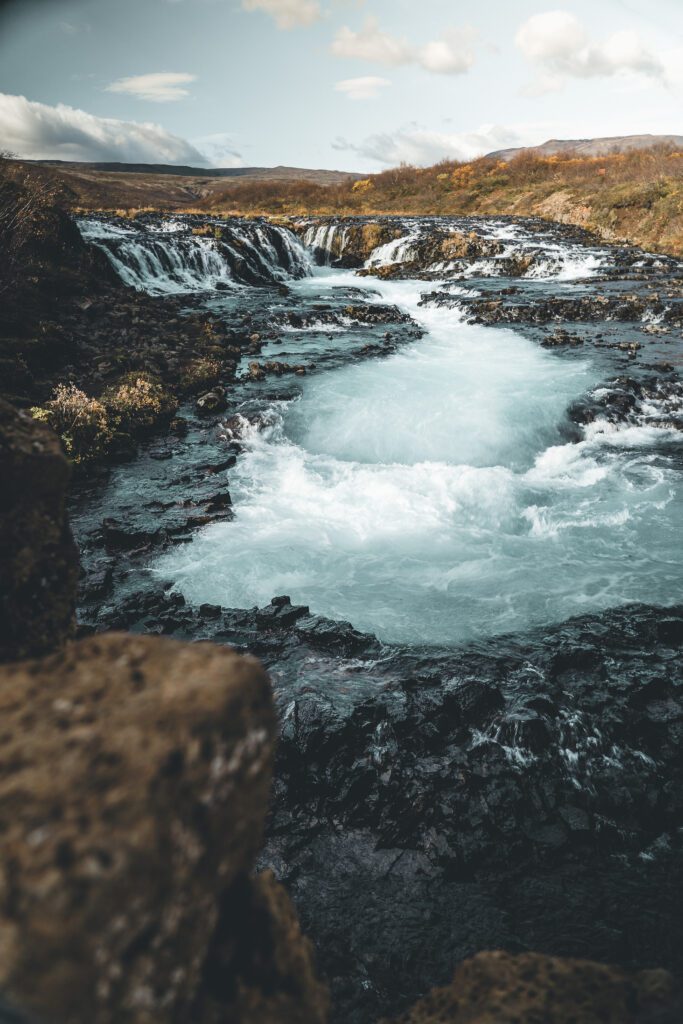November 20, 2024 – second largest eruption starts!
Our latest eruption has begun on the Sundhnúks crater series and while it is largely still in the same area as earlier eruptions; much of the westerly flow has subsided and most of the current lava flow from the two vents is pooling toward the east. It is not expected to travel any great distance and seems at this point to be fairly stable.
There are also reports of unhealthy gas pollution on nearby hiking trails and foothills of the mountains so be sure to connect with Road.is and Vedur.is before venturing out on your trip.
The Blue Lagoon is still largely protected by the man-made berms that were built around them; however lava did flow into their parking lot and has covered the main road into the area. Be sure to check out your lagoon alternatives if you were looking forward to the Blue Lagoon and they are unable to allow entry.
August 22, 2024 – a NEW eruption has started
This eruption is mainly limited to two areas north of Stóra-Skógafell and has already seen a significant slow down of seismic activity and ground deformation. Below is the most recent Hazard Assessment issued by the Icelandic Met Office

June 22, 2024 – The eruption has ended
After 24 days, the activity is finished and the Icelandic Met Office has declared that the eruption is over.
May 29, 2024 – a NEW eruption has started
another eruption started on the Reykjanes peninsula. The fissure opened near the previous eruption site and lava spread quickly, producing more lava than any other eruption in the past three years.
May 10, 2024 – six months since this system began
Today it’s been six months since the events started at Svartsengi and Grindavik making it one of the biggest geological disasters in recent Icelandic history.
March 16, 2024 – a NEW eruption has started
On Saturday, March 16th around 8:00 pm, a NEW volcano erupted on the Reykjanes Peninsula. There was very little warning of this eruption with no earthquakes preceeding. This is the 4th eruption in the same area since December 2023. The fissure grew quickly to about 3.5 meters long and scientists said this was the most powerful one of the last four, however just 12 hours later the activity had decreased significantly.
Here’s what YOU need to know:
Please keep in mind that foreign media always dramatizes their reports. This eruption is isolated to one small area on the Reykjanes peninsula (yes right next to the Blue Lagoon!) and the rest of Iceland is completely safe.
Should you still come to Iceland? Yes! You should not change, cancel, or postpone your trip because of these eruptions. This is simply the new normal for Iceland – the pattern of the last 4 eruptions has come on with very little warning and only lasted 24-48 hours, then repeated about 3-4 weeks later. Therefore we can expect another event in about a month. Life in Iceland continues as normal so there is no danger for tourists. The airport is not in any danger and flights are still coming/going as normal.
Note: you can NOT hike to this or ANY of the other eruptions, only local officials and media can get close. The roads leading to the active volcano are closed off for your safety.
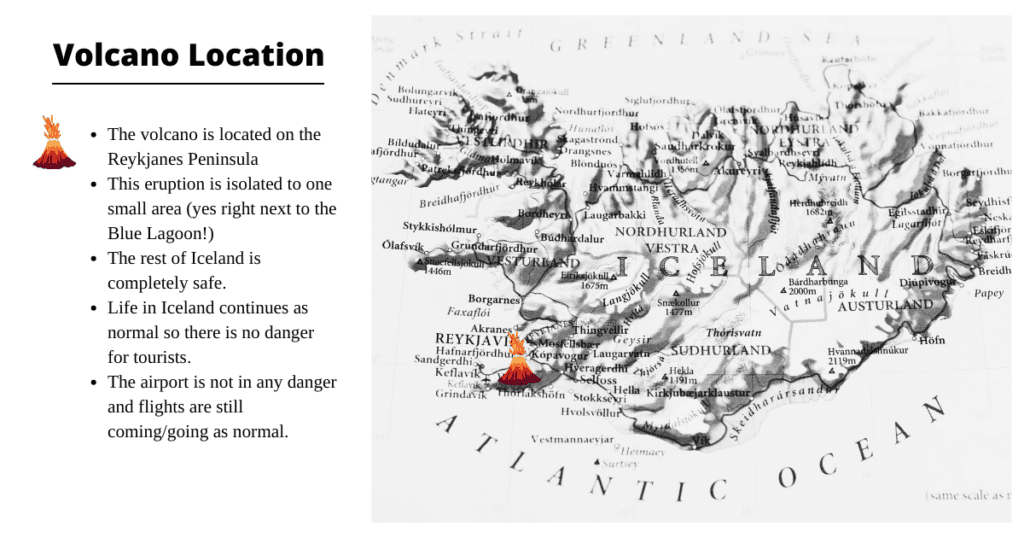
The Blue Lagoon is currently closed to visitors due to the ongoing volcanic eruption. However, based on their previous decisions to re-open as soon as the active lava is gone, they will re-open again. (See my statement about the Blue Lagoon below.)
February 9, 2024 – the eruption has ended
After an intense 24 hours of eruption and a massive amount of lava, the volcano has stopped erupting.
Always important to note: yes it is still possible and safe to travel to Iceland. Flights in and out of Iceland are not affected by this activity.
There is so much more to Iceland than what is happening on the Reykjanes Peninsula!
February 8, 2024 – a NEW eruption has started
A new volcano eruption started Thursday, February 8th at 6 am at Sundhnúkagygar near the same location as the December eruption. Grindavík was spared this time, however, earthquakes in the area continue to devastate the town and new cracks are opening all over.
This time the lava traveled extremely fast and far, nearly reaching the Blue Lagoon. In fact, guests sleeping at the Blue Lagoon hotel were woken by blaring alarms and had to be evacuated immediately – can you imagine your relaxing spa vacation interrupted by lava flowing towards your hotel?
Right now, it is not my recommendation to visit the Blue Lagoon. The Blue Lagoon is very close to the fault line and recent lava flows in the area have resulted in swift evacuations at the last minute. The last thing I want for you is to worry about the safety of you and/or your family while you are here!
As an alternative, I recommend the Sky Lagoon – it’s located near Reykjavík and will be just as relaxing and amazing. As with any of these experiences (and because of the recent volcanic activity) you’ll want to reserve your spot in advance to ensure you get the time you want.
The lava flowed over the major road that leads to Grindavík and the Blue Lagoon so now this area is completely inaccessible. Lava also reached one of the major pipes which distributes hot water to the entire peninsula, so homes were without hot water (as well as heat!) for a day while they had a backup source rerouted.
Here are some resources you might want to check out:
And some Instagram accounts that have good updates:
By the way…I know many of you still have questions and concerns about traveling to Iceland during this uncertain time. I will soon be filming a video about this topic so please submit your questions here!
January 19, 2024 – The eruption has STOPPED
After a few days of devastating events, there is no visible activity within the fissures.
The Blue Lagoon has re-opened.
However it’s important to note that inflation continues around the area, cracks are still opening up, and magma is likely trying to find another place to come through. Therefore another eruption could easily start again with little notice.
January 14, 2024 – A NEW volcanic eruption has begun
After a short but intense increase in seismic activity, another eruption started on the Reykjanes peninsula. The fissure opened near the previous eruption site and lava spread quickly, covering the main road into Grindavík.
Residents of Grindavík were evacuated immediately and the Blue Lagoon has been shut down as well.
Dams were previously constructed to keep the flow of lava away from the town, but soon after the main fissure opened a new fissure opened just north of the town of Grindavík threatening homes.
Over the course of a few hours the lava started to flow into the town and overtake several houses.
This has been a heartbreaking day for the residents of Grindavík as well as the country of Iceland as a whole – everyone is grieving and realizing that this tiny quiet fishing village will never be the same again, and perhaps never be safe to live in.
If you wish to donate to assist in the relief of the people of Grindavík you can do so at the Icelandic Red Cross. Donations go towards helping residents locate new housing and resources needed to restart their lives after the events of these earthquakes and eruptions has forced them to evacuate their homes leaving much of what they know and love behind.
For images and real-time updates Ruv.is is great resource.
Watch the live stream here:
December 21, 2023 – The eruption has STOPPED
After a few intense days and a quick diminishing of activity, the volcano is no longer erupting. Residents of Grindavík have been allowed to move back to their homes at their own risk. The Blue Lagoon remains closed.
December 18, 2023 – NEW Iceland volcano has erupted! Watch the live stream:
Monday night, an eruption started on the Reykjanes Peninsula after a short burst of earthquakes and only giving 45-minute warning.
The eruption site is about 50 kilometers (30 miles) southwest of Reykjavík, 3km North of Grindavík, and 2km (1.5 mi) East of the Blue Lagoon and a major power plant.
At this time no one has been hurt and no infrastructure has been damaged. There has also been no interruption to international or domestic flights.
This location is where the earthquake swarm began on November 10th, but there was a period where the activity died down.
Grindavík is still evacuated, but the craziest thing is that the Blue Lagoon (selfishly!) decided to open operations just days earlier.
The fissure stretched up to 4km and started by spewing magma at a much higher volume than the previous three eruptions.
⛔ WARNING: DO NOT attempt to hike to this eruption site. The eruption site is CLOSED for visitors at the moment and the winter weather conditions are treacherous. If you are in Iceland and wish to get to the eruption site to see this eruption up close, STOP. It is not yet safe to hike as lava is spreading at a rapid pace and gas emissions are higher than before and deadly. Stay away until further notice and keep checking SafeTravel who will notify when the site reopens.
Worried about how this will affect your Iceland trip? Read our Q+A from followers.
November 16, 2023 – Help! Donate!
The people of Grindavík have had their lives turned upside down.
Due to the earthquakes around the area, roads and buildings have been torn apart, land is sinking resulting in a lake threatening to swallow up homes, and sulfur dioxide has been measured. It became unsafe to allow people to stay, so authorities ordered that everyone evacuate as quickly as possible and were given very little time to grab their essentials. People were temporarily living with family or at Red Cross facilities, and now they have been moving to summerhouses around the countryside as well as nearby villages.
Starting today, Iceland with a view will donate a portion of profits from the shop to the Icelandic Red Cross and the volunteer Search and Rescue. If you are planning to use any of my trip planning materials know that you will also be supporting these organizations.
Alternatively, if you would like to donate directly, here is the information:
November 13, 2023 – Watch the Livestream:
The location of the magma and if/where it will reach the surface remains unknown. At this time seismic activity has died down but anything is still possible.
I highly recommend following these two on Instagram for updates: Volcano Activity Broadcast Channel and Ingibergur Thor (local photographer)
November 11, 2023 – Grindavík is in trouble
There is massive destruction to the town – roads and buildings torn apart, land sinking and a lake threatening to swallow up homes, and recently half the town lost power. Sulfur dioxide has also been measured confirming that magma is present and the probability of an eruption is high.
Due to the earthquakes around the area as well as massive damage to the roads and buildings, it became unsafe to allow people to stay. People were given very little notice to grab their essentials. For a temporary period people were living with family or at Red Cross facilities, and now they have been dispersing people to summerhouses around the countryside as well as nearby villages.
Q+A from followers
Is the international airport safe?
At this time flights are not affected. Of course that could change, but it’s likely that your airline would contact you directly if flights are affected.
In your experience, it will die down by the time we visit? (December)
It is impossible to predict what will happen at this point.
November 10, 2023 – Grindavík has been evacuated
Earthquakes M3-M5 have produced massive damage to roads and buildings of Grindavík.
Officials have confirmed that a magma tunnel is moving underneath the town.
Due to the earthquakes moving locations and the destruction, authorities demanded that everyone evacuate as quickly as possible. No one has been injured.
PLEASE NOTE: this is NOT the time to jump on a plane and try to come to Iceland. This series of events and possible eruption is VERY different from the previous three eruptions in that have been in an accessible location and away from infrastructure.
Additionally, drones have been banned around the area – this is NOT a time for photos and videos.
November 10, 2023 – MAJOR earthquake swarm near Blue Lagoon and Grindavik
The main road that leads to the Blue Lagoon has been damaged due to a large M5.2 earthquake and is now closed off.
PLEASE stay away from this area for your protection and to allow authorities to do their jobs.
This article in the Reykjavik Grapevine has a great play by play breakdown as the situation continues to intensify.
November 9, 2023 – The Blue Lagoon has CLOSED
There have been near 1,000 earthquakes near the Blue Lagoon so they have finally decided to close. Obviously a huge safety risk so it’s nice to see guests taken care of. Also note that any prepaid admission will be refunded during that time frame (but please contact the staff directly for assistance).
For those of you visiting Iceland in the next weeks be advised that it is still safe to travel TO Iceland, it’s just that this area specifically is not safe to travel around.
If you are looking for hot springs alternatives I recommend Sky Lagoon.
November 7 – The Blue Lagoon is in DANGER
Earthquakes have returned to the Reykjanes peninsula and it’s becoming more serious.
For those of you who aren’t aware…there is a volcanic fault line located on the Reykjanes peninsula, between Keflavík International Airport and Reykjavík.
The main concern now is THE BLUE LAGOON and the nearby power plant that provides hot water and heating for 21,000 households in the area.
There’s also a village of about 4,000 people nearby called Grindavík who now have an evacuation plan due to the anticipated eruption location.
THE PROBLEM IS: The Blue Lagoon is not informing their visitors that these earthquakes could lead to an eruption in which molten lava could reach the lagoon within MINUTES.
In fact, the bus companies have suspended transport to the Blue Lagoon, but they CONTINUE to remain open.
WHY?! This is absurd. I mean I can’t tell you what to do, but if it were me I would NOT be going to the Blue Lagoon until the earthquakes are done and or the area has been declared safe.
So far the land nearby has risen 7 cm and there’s a lava chamber 6 million cubic meters – this volcano looks to be more destructive than the previous three.
Minister of Justice Guðrún Hafsteinsdóttir says “we are at a level of uncertainty but not a level of danger or emergency in this context.”
SO. If you are traveling to Iceland soon and concerned about these events please read below.
October 31 – A NEW earthquake swarm is starting
Iceland is shaking again – More than 7,000 earthquakes have been detected on the Reykjanes Peninsula since October 25th. Along with the quakes comes a rise in the earth’s crust indicating an influx of lava beneath the surface looking for an exit.
The seismic swarm is still ongoing although the activity has slowed down. There is still a chance of earthquakes in the area. While there are no signs that an eruption is imminent, it is a possibility
Where, specifically, you ask? North of Grindavík and less than a kilometer away from THE BLUE LAGOON. This obviously is not good for the Blue Lagoon but even worse for the power plant that provides hot water and heating for 21,000 households in the area.
While there are no indications that an eruption is imminent, the Department of Civil Protection and Emergency Management has declared an uncertainty phase on the Reykjanes peninsula.
Remember: Experts have stated that the recent eruptions on Reykjanes indicate the start of a period of volcanic activity that could last decades or centuries. Up to this point, none of the three recent eruptions have impacted inhabited areas or infrastructure.
August 5 – the “Litli Hrútur” eruption has STOPPED
Magma is no longer actively coming out of the crater. It is still possible to hike to the eruption site as long as you follow safety precautions (detailed below).
July 23 – the volcano trail closes at 6pm EVERY NIGHT
Due to wreckless behavior from tourists, the volcano hiking trail will close at 6pm (18:00) every night. Recently, around 60 tourists nearly got surrounded by lava because they ignored the warnings from the search and rescue team. Regardless of the local authorities and us on the internet trying to warn this kind of behavior…they have ruined it for everyone else.
July 17, 2023 – The volcano hike is OPEN
The volcano is located directly between the airport and Reykjavik city. Please read the statement from July 12th if you want to visit the volcano. If you are interested in seeing it for yourself, you can rent a car and hike to the viewing location (use my VIP link and automatically save money on your car rental. Reserve your rental by July 31st and get 10% off your total rental price!!!)

July 13, 2023 – The Hiking Trail/Eruption Site is CLOSED
Chief of Police in Reykjanes has announced that for security reasons the whole area around this eruption and the ones from 2021 and 2022 will be closed until further notice. Respect the closures!
Note: It is still possible to see the eruption from the air – Book a helicopter tour
July 12, 2023 – Visiting the Eruption Site
Icelandic authorities have announced that the hiking to the eruption site is now open.
The area is accessible from Suðurstrandarvegur (the parking lots from previous eruptions), but not from other roads or road trails.
The route is 20 kilometers (12 miles) round trip over rough terrain and is rated difficult. It could take 6-8 hours depending on your hiking pace, plus extra time at the site so it’s EXTREMELY important to be prepared before even thinking of tackling this.
If you are planning to hike there, here are some things to keep in mind:
- This area is extremely dangerous!
- New fissures of lava could open without notice. Stay elevated and on marked paths only.
- The molten lava is spreading rapidly – the eruption grew to over a kilometer within hours.
- DO NOT WALK ON COOLED LAVA! What appears to be hardened lava could potentially have molten lava underneath making it unstable and extremely dangerous. People who do this will get the site closed down.
- Bring sturdy hiking boots, wind/waterproof layers, and plenty of water, and food. I also recommend hiking poles.
- A gas mask is needed – this eruption has higher levels of toxic gas than other eruptions and prolonged exposure could be toxic.
- Do NOT bring children or animals
- Use the parking lot for “Fagradalsfjall Parking P2” and pay the fee using the Parka App
- Check Safe Travel Iceland for detailed safety information before heading off.
Here is a map provided by Safe Travel. *I’ve also updated my digital maps to include the parking lot, hiking trail, and all the major features of the area.

July 10, 2023 – Iceland volcano has ERUPTED! Watch the Livestream:
An eruption has started on the Reykjanes Peninsula on July 10th, 2023 around 4:30 PM near Keilir after a week of earthquakes, one of which was M5.2 yesterday evening.
This eruption is called “Litli Hrútur” after the hill that it is near.
The eruption site is about 30 kilometers (19 miles) southwest of Reykjavík and at this time homes and infrastructure are not in danger. There has also been no interruption to international or domestic flights.
Vísir, RÚV, and Mbl have all placed webcams at different perspectives where you can watch live – check back frequently as the activity will spread!
WARNING: The eruption site is CLOSED for visitors at the moment. If you are in Iceland and trying to get to the eruption site, it is not yet safe to hike as lava is spreading at a rapid pace and gas emissions are higher than before and deadly. Stay away until further notice or check SafeTravel.
July 8, 2023 – M4.5 earthquake update from Iceland
The Icelandic Met Office reported THOUSANDS of earthquakes have struck the peninsula over the past few days, with 20+ larger than a magnitude of 3.0. The return of constant rumbling has geologists and volcanologists watching the area closely, and an eruption could be imminent.
Volcanologist Þorvaldur Þórðarson said there are signs (including the shallow depth of the earthquakes) that a considerable amount of lava is pooling below the surface, with the estimated location of an eruption being just north of Meradalir, which last erupted from August 3 to August 22, 2022.
For those of you who aren’t aware…the volcano is called Fagradalsfjall located on the Reykjanes peninsula, between Keflavík International Airport and Reykjavík. An ongoing fissure eruption that started in March 2021 after three weeks of earthquakes, and then again in August 2022.
NOTE: The main concern now is the tourists in the area around Fagradalsfjall, looking at the remnants of the last eruption. Approximately 200-500 people visit the site daily, so if you are currently in Iceland, stay away from the area!
A mini lesson on volcanoes
Iceland is nicknamed “the land of fire and ice” for a reason. It sits directly on a hot spot and on the divergent Mid-Atlantic Ridge, resulting in frequent volcanic activity. Volcanoes define the land, and their eruptions reveal gorgeous landscapes filled with lava fields, black sand beaches, peaks, and craters. The island has about 30 active volcanic systems, one of which was recently active.
Despite the threat of a pending eruption, Icelanders have come to not only accept but rely heavily on these volcanic systems in their daily lives. Geothermal energy brings hot water directly to homes and allows greenhouses to grow fresh fruits and vegetables year-round. The country is a major advocate of renewable energy, producing 30% of its electricity from geothermal stations. Swimming pools that drive the social culture are naturally heated with this hot water, and the tourism industry utilizes volcanoes for tours.
What to do during an earthquake
Because of its location on a plate boundary, earthquakes are a common occurrence in Iceland. Around 500 earthquakes are recorded in an average week, more if there’s activity in the active volcanoes. Iceland experiences two main types of earthquakes: from the movement of magma at volcanic zones, or as the tectonic plates move and release tension. Most of these earthquakes are mere tremors less than magnitude 3 and not felt by humans. Occasionally a magnitude 4 or 5 will hit an active volcanic zone which can be felt around the area.
Because the plates are diverging, a magnitude 5.0 and above is significant. Bigger earthquakes are rare, and the largest ever recorded was a magnitude 7.1 which happened in 1784. Icelandic regulations require buildings to be able to withstand these earthquakes so damage to structures is not very common. The biggest risk of earthquakes is injury due to objects falling from walls or shelves.
The best thing to do during an earthquake is to remain calm and stay away from loose objects.
If inside:
- Move away from things that may fall such as kitchen cabinets or things up on shelves
- find an open doorway
- hold onto the doorway (with one hand)
- cover your head (with the other hand)
If outside:
- Find an open space and avoid buildings and electric poles. Keep a safe distance from man-made structures that are as tall or taller than you.
- Duck and cover your head if you cannot get to an open space.
- Avoid falling rocks and gravel slides in mountainous areas.
- Those who are driving should stop their vehicles in a safe place.
*Note: when the volcano erupts, the earthquakes stop!
What to do if there is an eruption
*REMINDER: Experts have stated that the recent eruptions on Reykjanes indicate the start of a period of volcanic activity that could last decades or centuries.
Potential dangers of volcanic eruptions include hot lava flow, poisonous gases, ash fall, lightning, and glacial flooding. Depending on the location and type of volcano any combination of these hazards is possible. Eruptions can happen at any time but are usually preceded by an earthquake or a series of earthquakes.
In the event of being present during the start of an eruption, the best practice is to leave your things and travel as far away from the source as quickly and calmly as possible.
With the location and geography of the area of the current potential eruption, there is no need to be concerned with ash fall or glacial flooding. The earthquakes are centralized near the previous eruption sites so as a visitor to Iceland, the main concern is toxic gas emission if you are close to the eruption site.
If you happen to be in Iceland when the volcano starts erupting and want to see it for yourself, here are your options:
- Take a guided tour – safe and informative
- Fly over in a helicopter – VERY expensive, but incredible
- Hike to the volcano – for the adventurous
- WARNING: it’s CRITICAL that you properly prepare before the journey. The hike is longer than before and the weather conditions could change at an instant.
- I hiked to the first eruption and I made a video explaining everything you need to know to plan a safe visit to the volcano: How to plan the hike, Parking info, Difference between the trails, Websites to check for conditions, What you need to wear, What to bring on the hike Read the post // watch the Vlog
Other resources
- Iceland Met Office – Earthquake location and intensity map
- Safe Travel – alerts and warnings
- Geology Instagram account – scientific updates from a Geologist/Volcanologist
- Is there an eruption yet? – refresh, refresh, refresh!
- Ruv (Local News) – Livestream of the area
Q+A from followers
Is the lava flow headed toward RD 1 or 427? I would not want to get stranded on travel.
The lava is nowhere near the roads, it’s a 10km walk one way to get to the eruption site so at this time infrastructure is not in danger.
Any impact on the airport since it’s so close in proximity?
There has also been no interruption to international or domestic flights.
You can’t completely avoid the Reykjanes Peninsula since it’s the location of Keflavik International Airport. But honestly, the Reykjanes Peninsula is an area of Iceland that people usually forget about as a sightseeing destination. Most people leave the airport and head to Reykjavík and beyond so they end up driving past all the sights. Most earthquakes are only felt close to the epicenter, so if you don’t want to deal with the potential risks of earthquakes, just travel away from this area. Regardless of earthquakes or an eruption, it’s still safe to land in Iceland and travel about. If there are any risks with air travel, your airline will make that decision and notify you as needed.
Do you recommend still coming whether the volcano has erupted or not? How concerned would you be about the earthquakes and our flight?
YES! 100%. Tourism was not and will not be affected by the eruption. In fact, you will probably get FOMO if your trip doesn’t line up with the volcano eruption because it will be all over the news and social media and seeing this volcano up close is a once in a lifetime experience. The location of this particular volcano allows access up close and personal for locals and tourists alike.
Can you elaborate on what this may mean for summer (and beyond) travel?
Because of its incredibly accessible location (compared to other volcanos in Iceland) locals refer to this one as a “tourist volcano”. I expect summer travel to explode if the volcano erupts. Photographers, volcanologists, geologists, and excited tourists will flock to Iceland to witness this remarkable phenomenon. Lastly, Iceland is large enough with plenty of other areas to explore. Most of the sights that tourists have mapped out are away from the eruption site anyway, so just steer clear of the Reykjanes peninsula and stick to Golden Circle, South, East, North, or West Iceland.
Exciting times to be in Iceland! Stay safe out there my friends!

